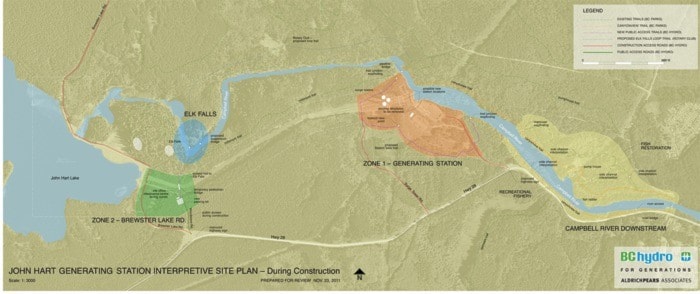No public access to the river trail near the BC Hydro generating station for five years.
No vehicle access across the John Hart Dam to Brewster Lake Road for three years.
Those would be two “short-term” measures enforced in order for long-term gains in BC Hydro’s mammoth $1.35-billion plan to upgrade Campbell River’s generating station.
“There are some impacts here – short-term impacts for long-term benefits,” said BC Hydro spokesman Stephen Watson.
The B.C. Utilities Commission will have the final say this spring on whether the project is approved – the most expensive project ever considered by the board, according to Watson.
“It’s just a little over a year away if things move forward,” he added during a meeting with the Mirror on Monday.
If approved, the project could begin by summer 2013 and would include:
- Building a new generating station.
- Replacing the wood stave pipelines running from John Hart Lake to the generating station with a two-kilometre tunnel.
The current John Hart Generating Station was built in 1947 and runs on six turbines producing 126-megawatts of electricity. However, due to age, the turbines are now rated at 118 megawatts and declining.
The new generating station, proposed to be built beside the current station, would only have three turbines, but would produce 135 megawatts.
The tunnel through bedrock would also be a vast improvement, in terms of seismic stability, over the wood stave pipelines. The project also has environmental benefits. Namely, BC Hydro could maintain water flow to the Campbell River which is critical for the survival of fish and other aquatic species.
“It’s a unique project. It goes through a BC Park (Elk Falls), a heritage river (the Campbell) and it’s very close to a city,” said Watson. “We’re trying to do our best within the confines of the site.”
It’s a “tight and narrow property,” he added, located on 248 acres, and that’s the reason for the trail and road closures. Public parking would also be closed around the generating station construction site due to safety.
However, a “Station View” trail would be built to skirt the site, allowing hikers to view the construction progress. Watson also said Hydro is working with Destiny River Adventures, which conducts river tours, to ensure their guides still have access, although there would still be restrictions from time to time.
Further up General Hill, vehicle access to Brewster Lake Road and Elk Falls Park would be closed for three years.
Near the bridge, BC Hydro plans to erect a public information building and create more parking to give hikers access to the park and falls.
To access Brewster Lake Road, Hydro is proposing a lengthy detour via the Island Highway and Gordon Road, or using the Iron River Road (the logging road bridge, downstream of the generating station).
“A traffic management plan has to be developed,” said Watson.
In another project, separate from BC Hydro’s plans, Campbell River Rotarians are proposing to build a suspension bridge over the Elk Falls canyon, just downstream of the falls itself.
BC Hydro has created a draft plan site which maps out the project (see drawing on A4) and it will be displayed at the next public meeting on Feb. 16, 3-7 p.m., at the Maritime Heritage Centre.
“We’ve engaged the community as much as we can during the last four years and this is another opportunity,” said Watson.
More detailed project information is also available online at byhydro.com/regeneration50 and by following the links.
